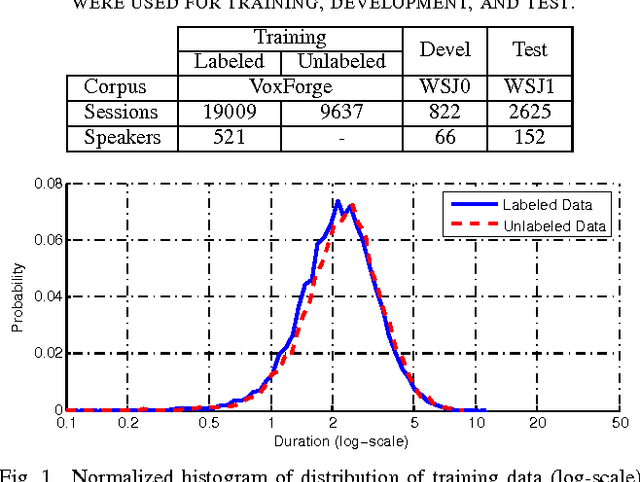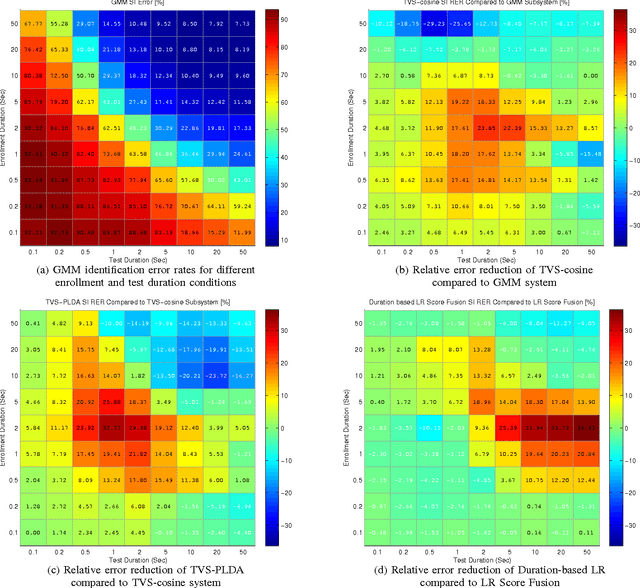Umut Uludag
Incorporation of Speech Duration Information in Score Fusion of Speaker Recognition Systems
Aug 07, 2016


Abstract:In recent years identity-vector (i-vector) based speaker verification (SV) systems have become very successful. Nevertheless, environmental noise and speech duration variability still have a significant effect on degrading the performance of these systems. In many real-life applications, duration of recordings are very short; as a result, extracted i-vectors cannot reliably represent the attributes of the speaker. Here, we investigate the effect of speech duration on the performance of three state-of-the-art speaker recognition systems. In addition, using a variety of available score fusion methods, we investigate the effect of score fusion for those speaker verification techniques to benefit from the performance difference of different methods under different enrollment and test speech duration conditions. This technique performed significantly better than the baseline score fusion methods.
Biometric Matching and Fusion System for Fingerprints from Non-Distal Phalanges
May 20, 2015



Abstract:Market research indicates that fingerprints are still the most popular biometric modality for personal authentication. Even with the onset of new modalities (e.g. vein matching), many applications within different domains (e-ID, banking, border control...) and geographies rely on fingerprints obtained from the distal phalanges (a.k.a. sections, digits) of the human hand structure. Motivated by the problem of poor quality distal fingerprint images affecting a non-trivial portion of the population (which decreases associated authentication accuracy), we designed and tested a multifinger, multiphalanx fusion scheme, that combines minutiae matching scores originating from non-distal (ie. middle and proximal) phalanges based on (i) simple sum fusion, (ii) NFIQ image-quality-based fusion, and (iii) phalanx-type-based fusion. Utilizing a medium-size (50 individuals, 400 unique fingers, 1600 distinct images) database collected in our laboratory with a commercial optical fingerprint sensor, and a commercial minutiae extractor & matcher (without any modification), allowed us to simulate a real-world fingerprint authentication setting. Detailed analyses including ROC curves with statistical confidence intervals show that the proposed system can be a viable alternative for cases where (i) distal phalanx images are not usable (e.g. due to missing digits, or low quality finger surface due to manual labor), and (ii) switching to a new biometric modality (e.g. iris) is not possible due to economical or infrastructure limits. Further, we show that when distal phalanx images are in fact usable, combining them with images from other phalanges increases accuracy as well.
Standard Fingerprint Databases: Manual Minutiae Labeling and Matcher Performance Analyses
May 08, 2013



Abstract:Fingerprint verification and identification algorithms based on minutiae features are used in many biometric systems today (e.g., governmental e-ID programs, border control, AFIS, personal authentication for portable devices). Researchers in industry/academia are now able to utilize many publicly available fingerprint databases (e.g., Fingerprint Verification Competition (FVC) & NIST databases) to compare/evaluate their feature extraction and/or matching algorithm performances against those of others. The results from these evaluations are typically utilized by decision makers responsible for implementing the cited biometric systems, in selecting/tuning specific sensors, feature extractors and matchers. In this study, for a subset of the cited public fingerprint databases, we report fingerprint minutiae matching results, which are based on (i) minutiae extracted automatically from fingerprint images, and (ii) minutiae extracted manually by human subjects. By doing so, we are able to (i) quantitatively judge the performance differences between these two cases, (ii) elaborate on performance upper bounds of minutiae matching, utilizing what can be termed as "ground truth" minutiae features, (iii) analyze minutiae matching performance, without coupling it with the minutiae extraction performance beforehand. Further, as we will freely distribute the minutiae templates, originating from this manual labeling study, in a standard minutiae template exchange format (ISO 19794-2), we believe that other researchers in the biometrics community will be able to utilize the associated results & templates to create their own evaluations pertaining to their fingerprint minutiae extractors/matchers.
 Add to Chrome
Add to Chrome Add to Firefox
Add to Firefox Add to Edge
Add to Edge